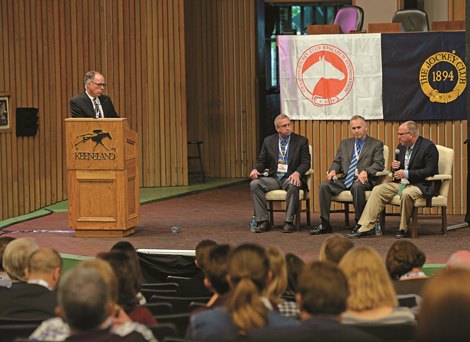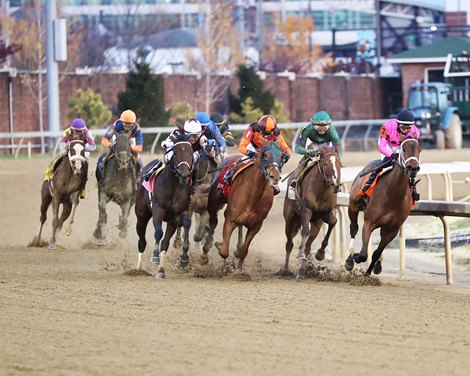Ahead of the landmark 150th Kentucky Derby (G1), Churchill Downs and others say a host of changes have been made to improve safety at the Louisville racetrack after a dozen fatalities last spring led its 2023 spring meeting to be concluded at Ellis Park in western Kentucky.
The most visible changes may be the new controlled-cut harrows that condition the racing surface and—to some extent—the racing surface itself.
Although Churchill Downs' official statement outlining its safety efforts didn't mention changes to the makeup of the racing surface, a number of trainers and a Horseracing Integrity and Safety Authority official said the surface has been changed.
"You can tell the surface is different," said trainer Todd Pletcher. "It's a different color. It's got a little different texture to it, different depth to it. We've only been here a short period of time, just kind of having our first round of breezes, but it appears to be in good condition."
Track superintendent Jamie Richardson said what Pletcher is likely seeing is the result of new controlled-cut harrows and a greater-than-normal amount of cushion material added to the track this year than in a typical year.
"It's not significantly different," Richardson said. "But racetracks are always changing as Mother Nature—whether it's wind or rain—washes (fine dirt) out and then you add material. You're always trying to add because that's what you lose is the silt and clays generally out of the racetrack. They wash out first and so you're always struggling to replenish them."
Although Richardson said the dirt track's mix of sand, silt, and clay isn't different than prior years, this year saw 2,200 tons of the dirt added compared with 750-1,000 tons normally.
"I needed more cushion," he said. "I was just getting to a year where 750, 1,000 wasn't enough, so we went ahead and put 2,200 tons out here."

This mix of new material is about 82% sand, with the rest being around 16% silt and 2% or less clay, he said. "We've always strived to be in that range."
The source was from Northern Kentucky that Richardson said he has purchased from before.
Mick Peterson, director of the Racetrack Safety Program at the University of Kentucky, works with Churchill to test the track. He said state-of-the-art new equipment includes harrows and new grading equipment with laser measurements.
"What Jamie's done is he's pretty much perfected the grading now on the track," Peterson said. "... He is just perfecting it. We've just never seen it this good. And Churchill has always been a good track ... but I've got no words for how good it looks this year. Imagine this, you've got a track the size of this, 50 to 80 feet wide, a mile long, and it's within a quarter of an inch, the depth, on that whole track.
"Go talk to a construction company and try to tell them you're going to try to stay within a quarter of an inch on an entire racetrack. But he's there and it sets a new standard and we've got to always keep getting better. We can't be complacent, and Churchill's just committed to this."
Peterson said the changes are not an indictment of the track last year, "far from it," comparing it to "continuous improvement" in manufacturing.
Churchill Downs-based trainer Greg Foley, whose barns abut the racetrack, credited Richardson for what Foley said is a better track than last year.
"From last year to this year, the surface is, in my opinion, much better for the good," said Foley, who has trained on his own at Churchill since 1981 and worked for his father, the late Dravo Foley, before that. "Historically, this track surface has always been a good surface."
The new controlled-cut harrows are more consistent, Richardson said, than the old diamond harrows that hung from a diamond frame and created ridges in their wake. The new harrows control the depth using six flotation tires that balance the frame.
"That fluffs up to about 3 1/2 inches of loose cushion," Richardson said. "You won't get a hard spot because they're heavy enough that they'll cut the hard spot. And you won't get a deep spot. The risk with the drag harrows is if you start to get a deep spot it might just continue to get deeper and deeper every time you harrow across it (because the frame would sink), where now that won't happen because the tires are supporting it."
Small "rakes" on the ends of the harrows create a smoother finish than the ridges created by the old harrows.
Not that Richardson believes the old harrows are to blame for last year's problems.
He noted that the new harrows were ordered in 2021 and were on hand last spring, he said, as Churchill was waiting on four-wheel drive tractors because its old two-wheel tractors couldn't pull the new harrows. Once they arrived, the new harrows were used last September, replacing the diamond-shaped harrows used at Churchill for decades.
While the new harrows are more consistent, Richardson said, "for the record, we had very safe years with those drag harrows."
Richardson said Churchill's turf course "is getting better as it ages into itself, it is getting more stable and more established."
The track's $10 million turf course that debuted in 2022 has underperformed by the track's own admission as racing on the surface has been limited.
"I hope we are out of that," Richardson said. The surface will be monitored and "if it starts showing signs (of an issue), we'll come off of it before anything happens."
Multiple investigations failed to find a specific root cause in last year's fatalities but did identify risk factors. A HISA report in September on the 2023 Churchill fatalities found "no causal relationship between the racetrack surface at Churchill Downs and the equine fatalities."
While the track passed that scrutiny, all involved are committed to improvements. In a pre-Derby safety news conference, HISA director of racetrack safety Ann McGovern said Churchill's surface changes and new equipment are paying dividends.
"Based on our pre-racing evaluation that HISA does on every racetrack prior to the beginning of its season, the metrics are much improved over last year," she said. "When I say 'much improved,' Churchill's surface was in very good shape last year, but it's improved even more with the added material and additional equipment."
One measure, she said, is how horses respond when racing and training on multiple surfaces.
"I think when we talk about uniformity and track surfaces," she said, "it's more about the mix of materials and how it's maintained and how the horse reacts to that material. That mix is going to be different on the East Coast than it will be on the West Coast, or in the Midwest," but the goal is "to maintain a surface so that when a horse goes from track to track, they don't feel a difference in the surface that may require some tracks and a different mix of materials or a different type of equipment to maintain it."
Foley said his initial reviews—and the ones he's heard from other horsemen—this spring are that Churchill's current surface meets that test.

"It's good and clean, and horses are going over it good," he said. "They're working pretty quick over it, but it's got a good bounce to it. So far, working your horses and running at Keeneland, horses are coming back good off of it. That's all that counts."
Track conditions and monitoring are only part of the efforts to improve safety.
"Everyone in the industry is trying to do everything that they possibly can to continue to improve the safety, and it looks like Churchill's made some significant changes to the surface, and hopefully a big component of that is safety," Pletcher said. "But it's on everyone's mind. It's everyone's responsibility to try to step up and take the initiative to continue to improve, and I think we're seeing that from all areas of the industry."
A number of Churchill Downs' safety efforts extend from the 2009 creation of its "Safety from Start to Finish" program.
Part of that is greater veterinary scrutiny—by Churchill and regulatory veterinary teams—of Derby horses that this year were required to be at the track a week before the race, two days earlier than last year. Oaks horses had to arrive by the same date.
This will be the first Derby week that HISA has had oversight of anti-doping efforts and controlled medication regulation, as it launched its ADMC May 22, 2023. It will be the second year it's had Derby week oversight of the sport's equine and rider safety.
Trainer Chad Brown said he believes HISA is good for racing.
"Does it have some things to work out? Of course it does," he said. "But I think some overall uniform regulation was really necessary. Everyone has to make a sacrifice here. ... I know that I've had to adjust to a few rules and things that I might not think are quite necessary or practical, but (overall) the benefit is there's so many things that come along with it that I think are helpful and necessary."
As for safety efforts in the industry more broadly, Brown said, "I can see a lot of progress so far and I'm actually quite excited for the future of where it's headed."









